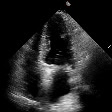Image synthesis is expected to provide value for the translation of
machine learning methods into clinical practice. Fundamental problems
like model robustness, domain transfer, causal modelling, and operator
training become approachable through synthetic data. Especially,
heavily operator-dependant modalities like Ultrasound imaging require
robust frameworks for image and video generation.
So far, video generation has only been possible by providing input
data that is as rich as the output data, e.g., image sequence
conditioning video.
However, clinical documentation is usually scarce and only single images
are reported and stored, thus retrospective patient-specific analysis
or the generation of rich training data becomes impossible with current
approaches.
In this paper, we extend elucidated diffusion models for
video modelling to generate plausible video sequences from single images
and arbitrary conditioning with clinical parameters. We explore this
idea within the context of echocardiograms by looking into the variation
of the Left Ventricle Ejection Fraction, the most essential clinical
metric gained from these examinations. We use the publicly available
EchoNet-Dynamic dataset for all our experiments. Our image to sequence
approach achieves an R2 score of 93%, which is 38 points higher than
recently proposed sequence to sequence generation methods.

















